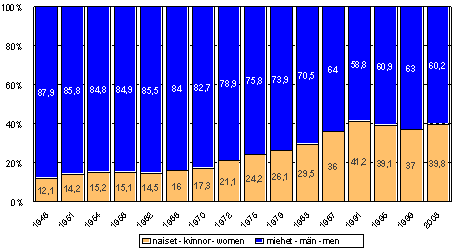Nomination of candidates in the Parliamentary elections 2003
In Parliamentary elections each party, electoral alliance or joint electoral list may nominate in each constituency at most 14 candidates. If, by virtue of a Government decision, more than 14 representatives are elected from a constituency, the number of candidates may be at most the number of candidates elected from that constituency. As in these elections 33 representatives are elected from the constituency of Uusimaa on the basis of a Government decision, each party had the right to nominate in that constituency at most the same number of candidates, i.e. 33.
Altogether 2,029 candidates were nominated for the elections,
which is 36 more than in the previous Parliamentary elections.
Eighteen parties participate in the elections, five of them as new
parties, while the others took part four years earlier as
well.
The majority, 70 per cent, of the candidates were nominated by the
present parliamentary parties - the Social Democratic Party, Centre
Party, National Coalition Party, Left Alliance, Green League,
Christian Democrats, Swedish People's Party and True Finns. The
total number of candidates in this group was 1,417.
The numbers of candidates nominated by the other parties not in the
present Parliament varied much. Among them, the highest number of
candidates was nominated by the Communist Party of Finland (172)
and the lowest by the Joint Responsibility Party (5). The number of
candidates from outside parties was only 27 in the whole country.
Four years ago this figure was still 68 and in the 1995 elections
it was 93.
The majority of the Parliamentary election candidates have
always been men. Now 1,221 of the candidates were men and 808
women. Women's proportion of candidates (39.8%) rose in these
elections by 2.8 percentage points compared to the 1999
Parliamentary elections.
When comparing the nomination of candidates by the present
parliamentary parties with the previous Parliamentary elections,
the proportion of female candidates has grown clearly among all,
with the exception of True Finns. For the third time already more
than one half (52.2%) of the Green League candidates are women. The
proportion of female candidates rose almost to one half in the
National Coalition Party and the Social Democratic Party as well.
In non-parliamentary parties the proportions of women candidates
were usually much smaller. Female representation was lowest in
Finland rises - People unite, only one women among 30
candidates.
Of candidates 70 per cent were aged 40 or over. This proportion was 75 per cent for male candidates and 63 per cent for female candidates. In all, 134 were aged under 25, of whom eight were aged 18 and 14 were 19 years old. The average age of all candidates was 46.2 years, that of male candidates 47.9 and that of female ones 43.7. (The age refers to the age of the candidate on the election day).
Men's and women's proportion of candidates in Parliamentary elections 1948 - 2003, %

Last updated 1.6.2005
Official Statistics of Finland (OSF):
Parliamentary elections [e-publication].
ISSN=1799-6279. 2003,
Nomination of candidates in the Parliamentary elections 2003
. Helsinki: Statistics Finland [referred: 25.12.2025].
Access method: http://stat.fi/til/evaa/2003/evaa_2003_2004-05-31_kat_001_en.html

